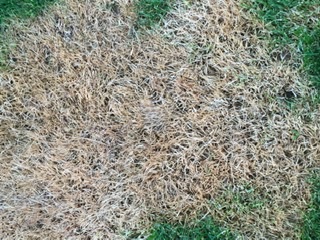
To Whom It May Concern;
I am having trouble with my lawn. We woke up one day to dead grass. (See pictures). My husband fertilized our lawn. I’m just wondering if that could be the problem and or what can be done?
Thanks in advance
Shari Klu
Lawn care is one of the most popular sources of questions for the Master Gardeners. If you go to the Toronto Master Gardener website, and put “lawn care” into the Find It Here search engine on our Homepage or the Resources page, you will find some fascinating lawn-related questions and answers.
It is very odd that although other areas of your lawn are fine and just this one area has died. The fact that you recently fertilized your lawn, suggests that the fertilizer may have caused foliar burn in this area. Based on the information provided by the University of Guelph; 310-0012 Growing Plant course information, fertilizer formulations come in 2 forms: granular and liquid.
- Granular fertilizers are the most common method of application. They usually contain 25 to 50% of the nitrogen in the slow-release form for safety (that is to prevent foliar burn). Check to make sure. A broadcast (centrifugal) spreader is the most common applicator.
- Liquid fertilizers are often applied by lawn maintenance firms to reduce labour costs but are also available to the home gardener. These forms may be advantageous when rapid growth is desired or there are soil or root issues however, the nitrogen ingredient, urea does cause foliar burn if the application rate is too high. The newer methylene urea forms are much safer and cause less grass injury when applied in the liquid form.
Chinch bugs and grubs also come to mind as possible pests, but you should have been able to see the little critters when you pull back a patch of the grass and look underneath.
There are some basic rules for a nice lawn. What you want is a nice-looking lawn not a perfect lawn. Consider the following:
- Soil: aerate your soil and add organic matter such as compost or top soil;
- Sow lawn seed that is specific for full sun, semi-shade, or shade, depending on what your growing conditions are. Too often the cause of lawn problem is planting the wrong type of grass for the type of care and sun conditions. Make sure your lawn seed is comprised of fescues with additions of rye grasses and stay away from a Kentucky Blue grass as it takes too much maintenance;
- Mow – mow regularly at a height of 2-3 inches. Leave the grass clippings on the lawn to add organic material back into the soil. In the summer, it’s best to mow the grass at a height of around 3 inches, as the taller grass helps to decrease the water lost via evaporation;
- Aerate and add seed to the grass in the autumn when the weather is cooler and rain is more likely;
- Fertilize the lawn in the spring and fall, not during a drought when the grass is stressed;
- Try to water in the early morning so that the grass will be less susceptible to fungal diseases. Water deeply in order to ensure the roots are well-nourished.
- Accept (and embrace) a lawn with clover and other plants in its mix. They will stay green much longer than grass in the heat and drought of summer. Please take a look at this resource from the Toronto Master Gardeners on the alternative to the ideal emerald-green perfect lawn: https://torontomastergardeners.ca/wp-content/uploads/2012/07/Lawn-Alternatives1.pdf
Good luck with your lawn.

